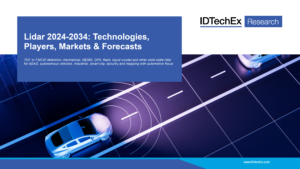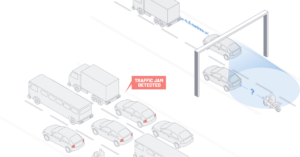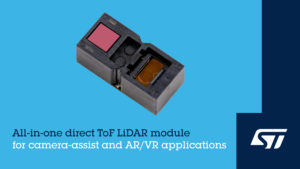Object Identification Functions

Lemur Imaging Demonstration of High Quality Compression Compared to Standard Quantization Techniques
Noman Hashim, CEO of Lemur Imaging, demonstrates the company’s latest edge AI and vision technologies and products at the March 2024 Edge AI and Vision Alliance Forum. Specifically, Hashim demonstrates Lemur Imaging’s high-quality memory reduction (LMR) image compression technology on different networks, showing that compression outperforms quantization in edge AI subsystems. The image quality delivered

The Integration of DMS and OMS Offers Advancements for In-cabin Monitoring
The Global In-Cabin Sensing Market Will Exceed US$8.5 Billion by 2034 In-cabin monitoring, comprising both Driver Monitoring System (DMS) and Occupancy Monitoring System (OMS), has experienced significant growth since the start of 2024. Traditionally, DMS relies on 2D infrared cameras, while OMS utilizes 3D sensing modules like 3D time-of-flight (ToF) cameras or radar modules. At

Exploring Gas Sensors: Assessing Technological Advances and Unveiling Business Opportunities
This market research report was originally published at the Yole Group’s website. It is reprinted here with the permission of the Yole Group. In recent years, there has been increasing awareness about health and the environment. Several devices with embedded gas and PM (Particle Matter) sensors have been developed to monitor air quality. At Yole

Enhancing Precision Agriculture with 20MP High-resolution Cameras for Weed and Bug Detection
This blog post was originally published at e-con Systems’ website. It is reprinted here with the permission of e-con Systems. Precision agriculture techniques have grown exponentially in the last decade due to the ever-advancing camera technologies. In this blog, we explore how a 20MP high-resolution AR2020 sensor-powered camera and its functionality help enhance precision agriculture

FRAMOS Demonstration of a Person-tracking AI Application Using a 1080p FSM:GO Optical Imaging Module
Prashant Mehta, Technical Imaging Expert at FRAMOS, demonstrates the company’s latest edge AI and vision technologies and products at the March 2024 Edge AI and Vision Alliance Forum. Specifically, Mehta demonstrates his company’s new FSM:GO optical imaging module product line. The details of this demonstration are as follows: Based on a 1080p video module, the

How LiDAR Helps Quick Service Restaurants Enhance Operations and Customer Experience
This blog post was originally published at Outsight’s website. It is reprinted here with the permission of Outsight. The Quick Service Retail (QSR) industry is perpetually evolving, with technological advancements playing a pivotal role in shaping customer experiences and operational efficiencies. The Quick Service Restaurant (QSR) industry, a vibrant and ever-evolving segment of the modern

A One-stop Solution for Digital Skin Analyzers
This blog post was originally published at e-con Systems’ website. It is reprinted here with the permission of e-con Systems. In this blog, we are exploring types of skin analyzers prevalent in the industry and giving insights on the kind of cameras that should be used to get the best results. In the skincare industry,

Vision Transformers vs CNNs at the Edge
This blog post was originally published at Embedl’s website. It is reprinted here with the permission of Embedl. “The Transformer has taken over AI”, says Andrej Karpathy, (Former) Director of AI at Tesla, in a recent episode on the popular Lex Fridman podcast. The seminal paper “Attention is All You Need” by Vaswani and 7

AI, Telehealth and Communications: Digital Healthcare
Software reading scans and online management of mental health are examples of digital healthcare that keep up with the modernization of the world, where efficiency and patient satisfaction are two key benefits. The weight of increasing demand for services could be lifted as more options become available for patients to seek treatment, and communication across

Balancing Safety with Efficiency: How LiDAR Transforms Airport Passenger Flow
This blog post was originally published at Outsight’s website. It is reprinted here with the permission of Outsight. Airports, as critical transportation hubs, play a dual role in ensuring passenger safety and maintaining a smooth flow of travelers. Balancing these two aspects is a challenging endeavor, especially in the face of evolving security threats and

Lidar 2024-2034: Technologies, Players, Markets & Forecasts
For more information, visit https://www.idtechex.com/en/research-report/lidar-2024-2034-technologies-players-markets-and-forecasts/995. The global market for lidar in automotive will reach US$9.5 billion by 2034 TOF or FMCW detection; mechanical, MEMS, OPA, flash, liquid crystal and other solid-state lidar for ADAS, autonomous vehicles, industrial, smart city, security and mapping with automotive focus In recent years, with the development and progress of autonomous-driving

Prompt Engineering in Vision
This blog post was originally published at Embedl’s website. It is reprinted here with the permission of Embedl. Recently, we have all witnessed the stunning success of prompt engineering in natural language processing (NLP) applications like ChatGPT: one supplies a text prompt to a large language model (LLM) like GPT-4 and the result is a

The Role of 3D LiDAR Technology in ITS
This blog post was originally published at Outsight’s website. It is reprinted here with the permission of Outsight. Intelligent Transportation Systems (ITS) are crucial for enhancing road safety and efficiency. LiDAR brings these systems to a whole new level. With the integration of advanced technologies like 3D LiDAR, ITS are undergoing a transformation, offering unprecedented

Detecting Real-time Waste Contamination Using Edge Computing and Video Analytics
This blog post was originally published at NVIDIA’s website. It is reprinted here with the permission of NVIDIA. The past few decades have witnessed a surge in rates of waste generation, closely linked to economic development and urbanization. This escalation in waste production poses substantial challenges for governments worldwide in terms of efficient processing and

Anonymous vs. Anonymized: Learn the Difference
This blog post was originally published at Outsight’s website. It is reprinted here with the permission of Outsight. Understanding anonymity in sensor data: discover the inherent privacy characteristics of each type of sensor data and the potential risks associated with anonymizing sensitive information. In the realm of computer vision, terms like ‘anonymized data’ frequently float

Edge AI in Medical Applications
This blog post was originally published at Digica’s website. It is reprinted here with the permission of Digica. A practical use for object detection based on Convolutional Neural Networks is in devices which can support people with impaired vision. An embedded device which runs object-detection models can make everyday life easier for users with such

STMicroelectronics Expands into 3D Depth Sensing with Latest Time-of-flight Sensors
Building on a leading position in direct Time-of-Flight sensors, with two billion FlightSense™ devices sold, ST reveals new direct and indirect Time-of-Flight sensors for key applications like camera assist, virtual reality, 3D webcam, robotics and smart buildings Market-first true all-in-one dToF LiDAR module with up to 2.3k zones, targets smartphone camera-assist and AR/VR applications The

Tesla Adopts Radar for Interior Monitoring
With the shift towards electric vehicles, end-users are becoming less concerned about traditional differentiators like engine horsepower and are placing greater emphasis on smart interior functions. This trend is compelling automotive OEMs to invest more efforts in enhancing interior features, thereby adding greater value to their products and distinguishing them from other vehicles. Driven by

